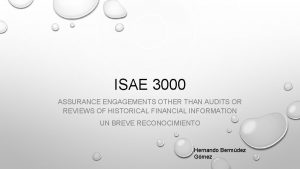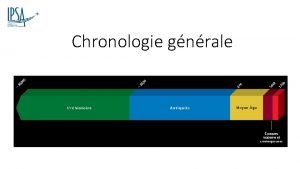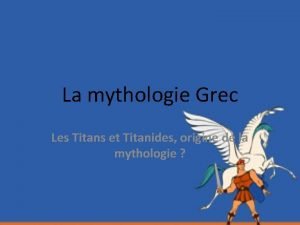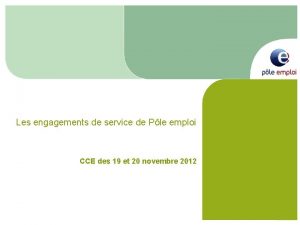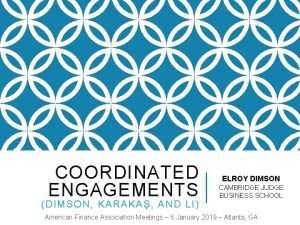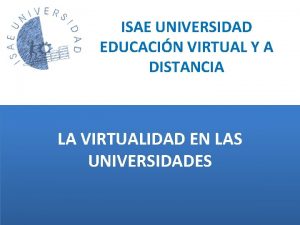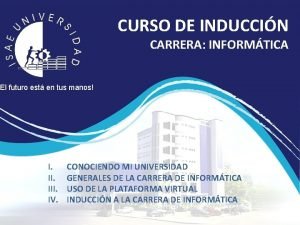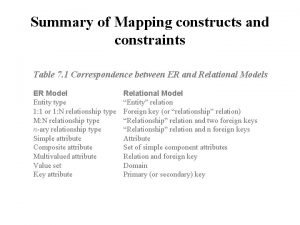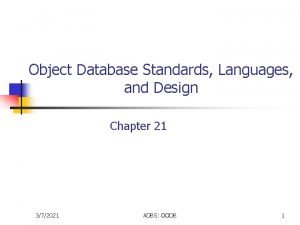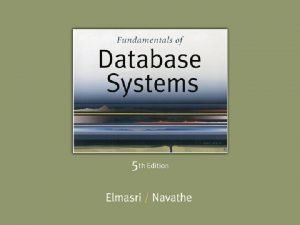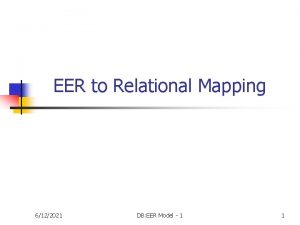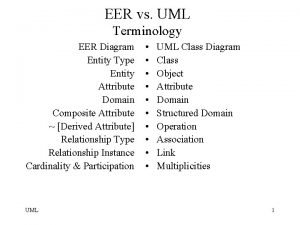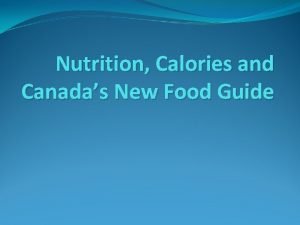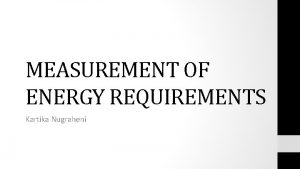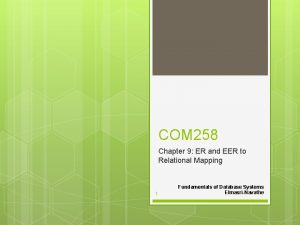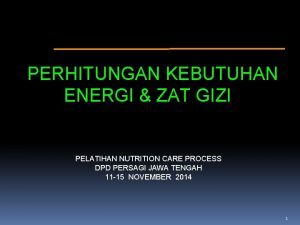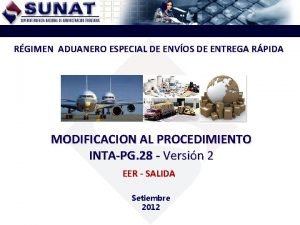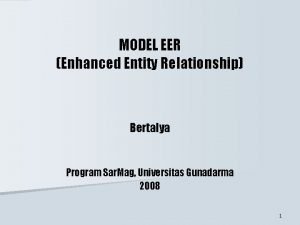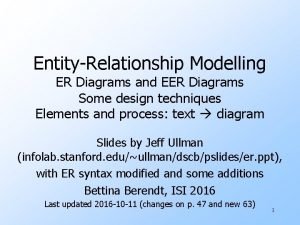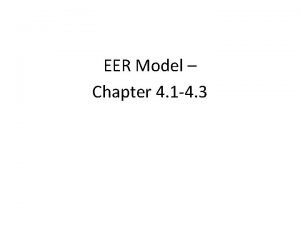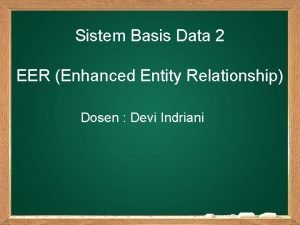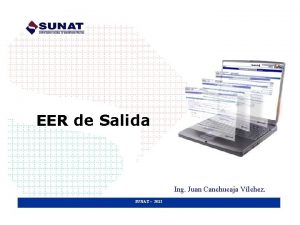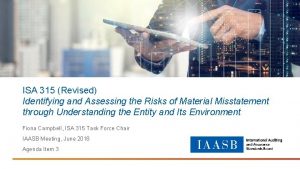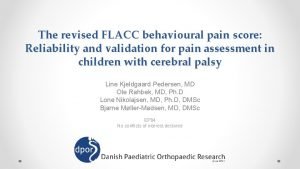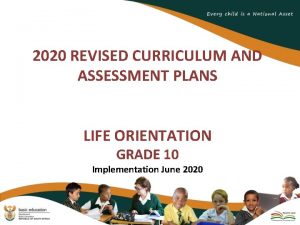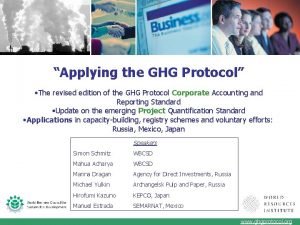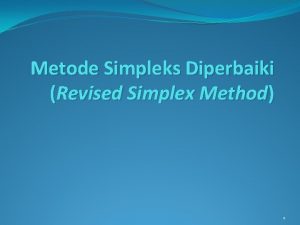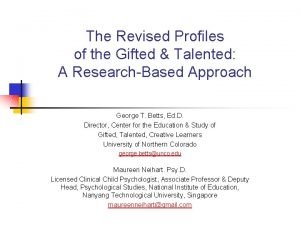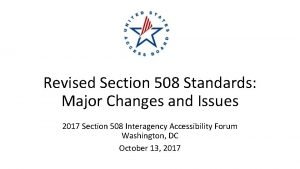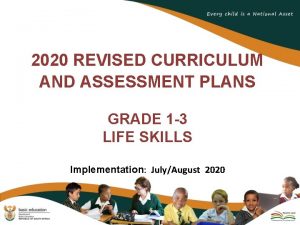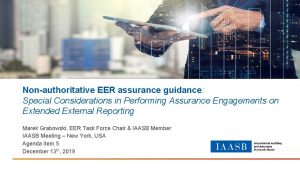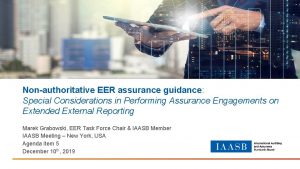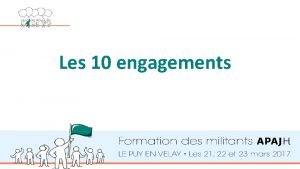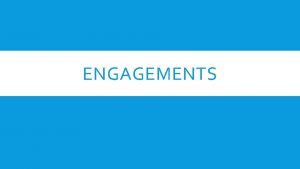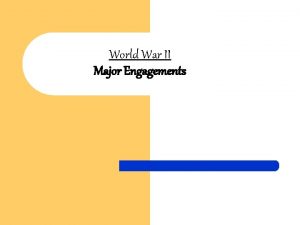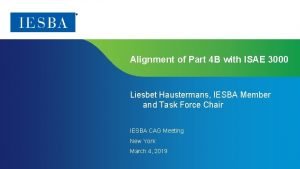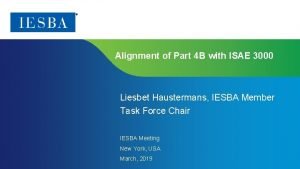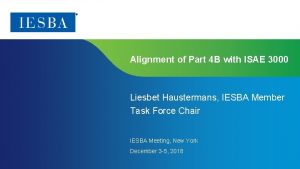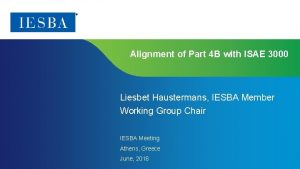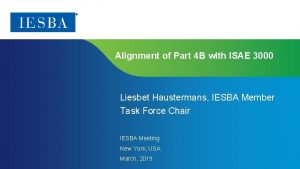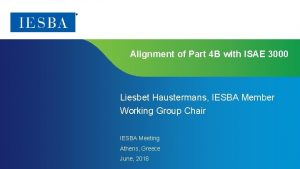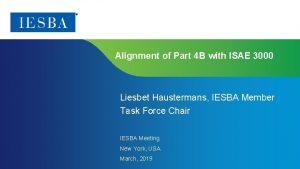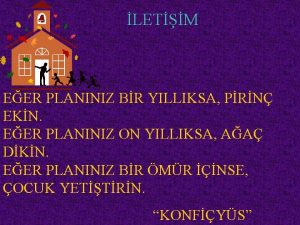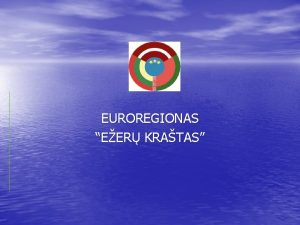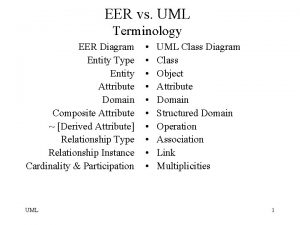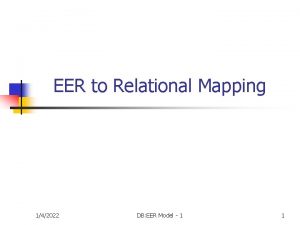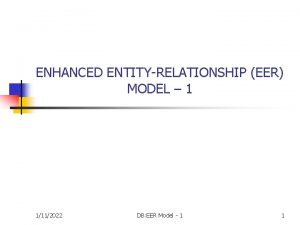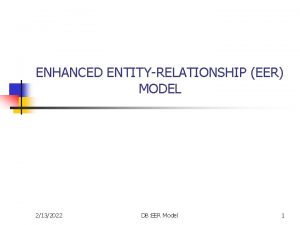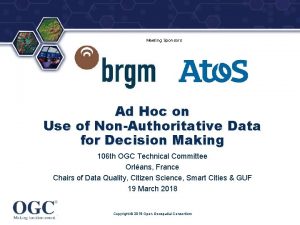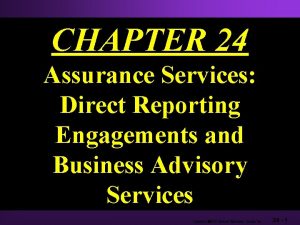EER Assurance Engagements Applying ISAE 3000 Revised Nonauthoritative




































- Slides: 36

EER Assurance Engagements Applying ISAE 3000 (Revised) – Non-authoritative Guidance Marek Grabowski, EER Task Force Chair & IAASB Member IAASB Meeting – New York, USA Agenda Item 6 September 17, 2019

Agenda for Today 14: 00 – 15: 00 Consultation Paper responses and Task Force proposals 15: 00 – 15: 30 Phase 2 draft guidance to date: Chapter 3 15: 30 – 16: 00 Break 16: 00 – 17: 30 Phase 2 draft guidance to date: Chapters 4, 5, 10 -12, 14 Page 2

Consultation Paper (‘CP’) Responses • Generally positive support • Comments related in the main to: – Length and complexity – Examples to cover broader range of EER frameworks – Work effort for preconditions pre- and postacceptance – Determining suitability of criteria is challenging – Materiality process including terminology – Assertions – Limited vs reasonable assurance • Many detailed drafting suggestions • Some comments on matters related to phase 2 or not in scope Page 3

CP Responses – Overarching Themes Relating to Guidance as a Whole • Guidance long, complex, difficult to navigate • Focus should be on EER-specific challenges, but useful to also provide educational background • Sustainability reporting addressed well; value creation not sufficiently addressed • Differential requirements for limited and reasonable assurance • ‘Future-proof’ guidance: consider evolution in EER reporting (including technological) and implications for assurance • Clarify linkages between guidance, Standard and other subject-specific standards Page 4

TF Proposals to Address Overarching Themes Relating to Guidance as a Whole • Restructure guidance: – Main body of guidance: practical guidance and short examples – Appendix: longer/more complex examples – Supplement: Background and Contextual Information – Use hyperlinks between main body of guidance, Appendix and Supplement • Broaden range of examples • Address differential requirements for limited and reasonable assurance • Acknowledge technology and other developments, but principles remain the same • Address detailed drafting suggestions in drafting combined guidance Page 5

Question 1 Themes on Scope of Guidance (paras 9 -15 of CP) and TF proposals to address themes • Clearly define EER engagements, intended audience and purpose • Guidance would be helpful on: – Using the work of others – Financial information in EER reports – Quality control (and compliance with ISQC 1 or similar standard) – Direct engagements • Task Force proposals: – Identify subject matters covered under ISAE 3000 (Revised) and whether they are EER engagements – Clarify focus is non-authoritative guidance for assurance practitioners on EER key challenges – Guidance on using work of others, ISQC 1, and financial information to be developed in phase 2: – Direct engagements outside of project proposal, but clarify that guidance may be applied where challenges present Page 6

Comments and Questions on Structure and Scope Page 7

Question 1 Themes on Preconditions and Internal Control (paras 25 of CP) • Guidance generally supported • Some concerns raised about: – Differentiating work effort pre- and post-acceptance, and iterative nature – Apparent inconsistencies between paragraphs 45 and 60 of draft guidance – Interrelationships between preconditions • Further guidance needed: – On readiness assessments – To recognise a substantive approach is possible – On rational purpose: point in time engagements; inappropriate association of the practitioner’s name; direct contact with users Page 8

TF Proposals to Address Themes on Preconditions and Internal Control • Guidance cannot provide a ‘bright line’ on work effort pre- and post- acceptance, but can indicate factors and give examples of factors • Further guidance on readiness assessments included in phase 2 material • Clarify paragraphs 46 and 60 to address apparent inconsistencies • Other comments to be considered during further development of phase 2 guidance Page 9

ma Question 1 Themes on Suitability and Availability of Criteria (paragraph 29 of CP) • Determining suitability of criteria challenging in practice • Call for examples to address non-prescriptive nature of principles-based frameworks, for example, Integrated Reporting, IASB’s Management Commentary Practice Statement, UK Strategic Report • Need for further guidance on: – Availability of criteria, and changes in criteria – Consideration of how preparer has identified user needs – Clarifying apparent inconsistency between presumption that established criteria are suitable and need for entity-developed criteria when using some established frameworks Page 10

TF Proposals to Address Themes on Suitability and Availability of Criteria • Further examples to illustrate thought process, including understanding user needs and changes in criteria • Clarify that criteria under an EER reporting framework are unlikely to be sufficient without supplementary entity-developed criteria • Clarify apparent inconsistency by explicitly stating that high-level principles-based framework is an indicator that framework may not be suitable on its own • Clarify that it is a precondition for criteria to be made available Page 11

ma Question 1 Themes on Materiality Process (paragraph 33 of CP) • Chapter 8 provides useful guidance on a complex area • However: – Terminology is confusing – Clear linkage needed between practitioner’s consideration of the ‘materiality process’ and of preconditions – The needs of intended users are crucial – Guidance should not imply an obligation to review ‘materiality process’ – There is a need for the preparer to consider more than ‘impact’ in developing criteria – Clarification needed on disclosure of materiality process – Guidance would be helpful on the use of multiple frameworks as sources of criteria Page 12

TF Proposals to Address Themes on Materiality Process • Develop different term to describe a preparer’s process • Further examples to show criteria are developed and applied and link consideration of ‘materiality process’ and preconditions, and to illustrate considerations where multiple frameworks are used • Clarify that preparer’s ‘materiality process’ may be a useful source of evidence about suitability of criteria • Clarify that disclosure not generally required (although some frameworks may require), but may be helpful to users Page 13

ma Question 1 Themes on Materiality of Misstatements (paragraph 35 of CP) and TF proposals to address • More guidance is needed on: – Qualitative materiality – Disparate aspects of underlying subject matter with no common basis for aggregation – The meaning of ‘clearly trivial’ – Consideration of materiality in planning and performing the engagement – Considering the structure of the overall report and the priority with which the information is presented • One respondent noted that misstatements arising from ‘not knowing’ could be material • Task Force actions and proposals: – Some new guidance included and currently being developed further to address comments raised (subject to TF views in paragraphs 60 -62 of the Issues Paper) – ‘Not knowing’ is not a misstatement, but may be a reason for one occurring or not being detected – Guidance on considering materiality in planning and performing the engagement allocated to phase 2 Page 14

Comments and Questions Page 15

ma Question 1 Themes on Assertions (paragraph 40 of CP) and TF proposals to address themes • Respondents generally supportive of the guidance on assertions; some concerns about: – Length and complexity – Usefulness to practitioners not familiar with the concept of assertions – Apparent inconsistencies with ISA 315 and ISAE 3410 – Whether assertions for an EER engagement should be consistent financial statement assertions – The omission of ‘valuation’ and ‘completeness’ assertions; the need to further explain ‘free from error’ and ‘connectivity’ • One respondent considered that introducing the concept of proper application of criteria may imply a ‘fair presentation’ consideration • Task Force proposals: – Focus on practical use of assertions through illustrative examples – Clarify that assertions are categorizations; there may be different ways of categorizing them – as long as all the ‘what can go wrongs’ are addressed – Remove ‘free from error’ as it relates to all assertions – Clarify intention is not to imply the need for fair presentation criteria Page 16

ma Question 1 Themes on Narrative and Future-Oriented Information (paragraph 41 of CP) • Respondents generally supportive, but offered some suggestions for further development of guidance: – Emphasize need for strong criteria, and include examples of suitable criteria and procedures to obtain appropriate evidence – Should not create the expectation that all narrative and future-oriented information is capable of being assured – Narrative and future-oriented information should be supported by a sufficient system of internal control – A clear definition of ‘narrative information’ needed so it is clear what is ‘other information’ – Draw out that a stable history of accurate forecasting provides a stronger evidential basis for a forecast than where there is no such history Page 17

TF Proposals to Address Themes Narrative and Future-Oriented Information • Chapters 11 and 12 include draft phase 2 guidance on: – Need for preconditions to be present, including processes to prepare the subject matter information provide a reasonable basis – How subjective statements may be revised – What constitutes ‘other information’ • Further consideration has already been given to the example in paragraph 195 example and changes made • Further examples to illustrate the challenges and considerations for narrative and futureoriented information Page 18

Question 2 Themes Relating to Use of Examples and Diagrams, and Terminology • Examples and diagrams generally considered useful, and a call for more, and a broader range of, examples, but: – Both financial and non-financial examples would be helpful – Some respondents in favour of an end-to-end case study – Examples should not suggest the only way to approach the requirements – Examples should illustrate possible courses of action • Terminology: – Avoid introducing new terminology when existing terminology could be used – Some terminology confusing (materiality process, elements, qualities, assertions) – A glossary or definitions of new terms would be helpful Page 19

TF Proposals to Address Question 2 Themes - Diagrams, Examples and Terminology • Focus on practical application through the use of more, and a broader range of, examples • Specific comments on diagrams and examples to be considered further • Revisit the terminology used and consider it can be simplified or clarified; consider need for including a glossary once terminology has been reconsidered Page 20

Question 3 Themes Relating to Structure • Themes included: – Use innovative ways to present guidance to assist in navigability – Use a flowchart to help navigate, to link the stages of the engagement, and show the iterative nature of considerations – Some reordering of chapters may be needed (e. g. chapter 8 earlier in the document) • The TF proposes to make the guidance more practical and user-friendly by: – Separating main body practical EER-specific guidance from longer examples and background material – Using a flow diagram to show each stage of the engagement – Using hyperlinks and icons to improve navigation – Considering the ordering of chapters once the combined phase 1 and phase 2 guidance is developed Page 21

Questions 4&5 Themes Relating to Potential Conflicts with and Matters not Addressed in the Standard and TF views • Concern about suggestion of preliminary knowledge needed of an entity’s internal control and implied obligation for practitioner to review the preparer’s ‘materiality process’ (considered under Question 1) • The guidance should not inadvertently suggest new requirements or best practice • Clearly identify matters that are not addressed by the Standard • Consider amending the Standard for the guidance developed • A number of individual comments noted – further consideration to be given to these in drafting phase 2 guidance • Task Force views: – Chapter 1 of the guidance states that it is not intended to introduce new requirements; wording to be carefully reconsidered – It would not be consistent with the guidance being non-authoritative to propose conforming amendments to the standard Page 22

Question 6 Themes and Task Force Proposals Relating to Additional Papers • Most respondents: – Agreed that the additional papers contained further useful information – Supported publication alongside the non-authoritative guidance – Provided additional suggestions for improvement • The Task Force proposes to: – Move useful background material from phase 1 guidance to a Supplement, combining with the additional papers in the CP – Clarify intended purpose and audience of the non-authoritative guidance, Appendix and Supplement and improve linkage Page 23

Question 7 Themes and Task Force Proposals on Other Matters • Various individual stakeholder perspectives noted: – Limited reference to the internal audit function – Greater prescription would assist smaller entities • No particular issues noted regarding developing nations • Ten respondents raised some specific concerns about translation due to complexity of language and new terminology • The Task Force: – Has developed some guidance on using the work of others (chapter 4); further consideration being given to examples to include the use of the work of Internal Audit and others – Acknowledges the need for scalability; more prescriptive guidance is outside the remit of this project – Terminology to be revisited Page 24

Comments and Questions Page 25

Phase 2 Guidance – First Draft The EER Assurance House (under construction) Communicating Effectively in the Assurance Report Evaluating Suitability of Criteria Applying Materiality Building Assertions Maturity in Governance & Internal Control Challenges allocated to phase 1 & Addressing Narrative and Future. Oriented Information Challenges split between phase 1 and phase 2 Challenges allocated to phase 2 Determining the Scope of an EER Assurance Engagement Exercising Professional Skepticism and Professional Judgment Obtaining the Competence Necessary to Perform the Engagement Page 26

Chapter 3 – paras 13 -51: Determining the Scope of an EER Assurance Engagement • Wide variety in scope of assurance engagements in practice • Meaning of Scope of Assurance • Breadth – Can be an entire report or only part(s) of an EER report – Engagement acceptance linked to preconditions, especially rational purpose – Cherry picking – Increasing breadth – rolling program • Depth – Level of assurance – acceptably low engagement risk – in circumstances of the engagement • Other issues revisited – Other Information – work effort relating to preconditions – assurance readiness engagements Page 27

Comments and Questions Page 28

Chapter 4 – paras 52 -74: Applying Appropriate Skills • Diversity, breadth and characteristics of subject matter – Increases complexity in some engagements – Drives need for wide range of skills and experience Engagement partner and engagement team competence • Competence model different from financial statement audit • Engagement partner – high assurance competence; enough SM competence to take responsibility • Competence considerations in assignment of team may be complex – Assurance competence and subject matter competence – Multi-disciplinary teams – Skills matrix – Competence cube – Quality control Page 29

Chapter 5 – paras 75 -92: Exercising Professional Skepticism and Professional Judgment • Many aspects of EER that require PS and PJ • Skills and experience needed to exercise PS and PJ • Professional Skepticism – Attitude of mind – actions taken as a result – Behaviours and skills that support exercise of PS – Impediments to exercise of PS • Professional Judgment – Application of training, knowledge and experience – decisions about courses of action • PJ/PS - Practical examples and icons to flag throughout guidance PJ PS Page 30

Comments and Questions Page 31

Chapters 10 -12 – paras 93 -148: Obtaining Audit Evidence in Respect of Narrative and Future-Oriented Information • New Chapter 10 on general aspects evidence and thought process – Evidence needed and sources – Design and performance of procedures – Evaluating sufficiency and appropriateness of evidence • Illustrative example for thought process (quantitative information) • How much evidence is enough? – Limited v reasonable assurance – Not discrete models – Procedures for obtaining evidence essentially the same • Guidance and examples to illustrate application of thought process to narrative and futureoriented information (integrated with guidance in previous Chapters 10 and 11 (now 11 and 12) Page 32

Chapter 14 – paras 149 -196: Communicating Effectively in the Assurance Report • Convey conclusion and its basis to enhance user confidence – Scope and level of assurance obtained - criteria used • Complexity in underlying subject matter of some EER engagements impediments to effective communication • Short or Long form choice – Flexibility in including additional information, but needs professional judgment – Required summary of work performed • Additional information may facilitate effective communication and help address expectation gaps • Guidance and examples showing how additional information may enhance effectiveness of communication for each basic element of the assurance report Page 33

Comments and Questions Page 34

Next steps • Completion of combined phase 1 and 2 guidance – To be presented to IAASB in December to seek approval of exposure draft – Exposure draft planned for early 2020 Page 35

www. iaasb. org For copyright, trademark, and permissions information, please go to permissions or contact permissions@ifac. org.
 Isae 3000 vs 3402
Isae 3000 vs 3402 Isae 3000 revisada
Isae 3000 revisada 3000+3000+2000
3000+3000+2000 Titans et titanides
Titans et titanides Statements on standards for attestation engagements
Statements on standards for attestation engagements Les 5 engagements de pôle emploi
Les 5 engagements de pôle emploi Coordinated engagements
Coordinated engagements Isae plataforma virtual
Isae plataforma virtual Plutarco arrocha
Plutarco arrocha Enhanced entity-relationship model
Enhanced entity-relationship model Enhanced entity relationship diagram
Enhanced entity relationship diagram Eer
Eer Mapping an eer schema to an odb schema
Mapping an eer schema to an odb schema Eer modell
Eer modell Eer
Eer Erd vs uml
Erd vs uml Canada's old food guide
Canada's old food guide Perbedaan rumus mifflin dan harris
Perbedaan rumus mifflin dan harris Er and eer
Er and eer Rumus ree
Rumus ree Ieer vs eer
Ieer vs eer Manifiesto eer
Manifiesto eer Enhanced entity relationship adalah
Enhanced entity relationship adalah Eer diagram
Eer diagram Eer model
Eer model Contoh eer diagram
Contoh eer diagram Manifiesto eer
Manifiesto eer Isa 315 revised
Isa 315 revised Electrical technology grade 12
Electrical technology grade 12 Revised flacc
Revised flacc 2020 revised curriculum and assessment plans
2020 revised curriculum and assessment plans Ghg protocol revised
Ghg protocol revised Revised simplex
Revised simplex Grade 7 geography term 1
Grade 7 geography term 1 Betts neihart profiles of the gifted and talented
Betts neihart profiles of the gifted and talented Revised section 508 standards
Revised section 508 standards Revised curriculum and assessment plans 2021
Revised curriculum and assessment plans 2021

